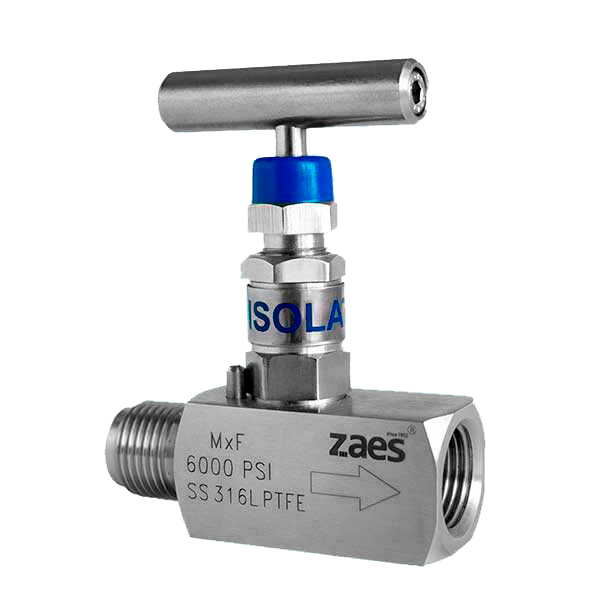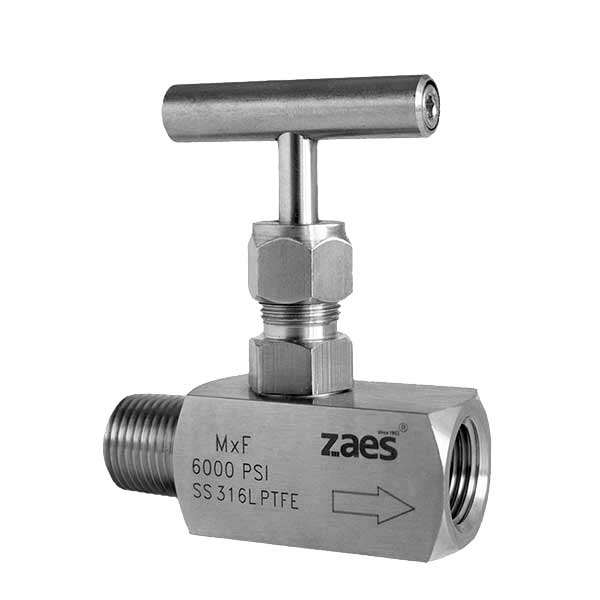What is a valve
Needle
A needle valve in stainless steel and other alloys are valves that can be used to regulate the flow of a substance (usually gas needle valves or water needle valves) through an apparatus or system. The unique feature of this value is that it contains a small plunger in the shape of a needle (as the name suggests).
Needle valves in stainless steel and other alloys owe their name to a tapered stem, which acts as a plug in a bore of small diameter in relation to the nominal diameter of the valve.
The movement of the valve stem, if it is a fine threaded valve, is slow, in fact, the part of the fluid passage is not the smallest until many turns, because of its stability this valve becomes a good flow regulator. The design of the precision obturator favours a good metal sealing, with little wear and can prevent cavitation in case of high pressure differences.
You can find designs that arrange the inlet and outlet ports of the valve in angled, straight (90°) or linear (0°) shapes.
Features and functions
of a needle valve
The needle valve is a well-known type because it is commonly used in industrial installations. It has a conical stem/shaft that can open, close or partially block ducts or bores. It is relatively small and therefore suitable for any pressure system with previous dimensions.
Like other types, the purpose of this needle valve is to effectively and safely regulate the fluid flowing through the circuit. Its name comes from its design, as it has a conical stem/shaft that serves as a plug for the bore, and its diameter is very small compared to the nominal diameter.
In this type of industrial needle valve, the valve stem has fine threads and the displacement is very slow. In addition, the cross section of the fluid channel before turning is small, which makes it an excellent choice for regulating flow.
What types of needle valves are there?
As a manufacturer of needle valves for more than 60 years, Zaes guarantees a quality product for your installations.
They are usually made of AISI 316 L stainless steel, carbon steel, Monel, Inconel, Hastelloy, duplex steel and super duplex steel.
It should be added that they should consider the most suitable material for their application, which will help them to extend the life cycle of the valve and keep the system safe and active for a long time.
Needle valves are commonly used in high and low pressure hydraulic systems, chemical processing and other liquid and gas applications.
Depending on their materials, they can also be used in oxygen or high temperature systems.
Operation of the
Needle Valves
- Adjust the flow rate by turning the knob. Clockwise rotation decreases the flow rate and counterclockwise rotation increases the flow rate.
- Close the valve with manual force only. Use pipes or spanners for no reason.
- If the valve is at high temperature, be aware that you may burn your hands during operation.
- In the actuating valve, the integral mechanical actuator sends an open or close signal.
- Do not leave the valve stationary for a long time. It is recommended to run it regularly to ensure its correct and continuous operation.

A needle valve in stainless steel and other alloys are valves that can be used to regulate the flow of a substance (usually gas needle valves or water needle valves) through an apparatus or system. The unique feature of this value is that it contains a small plunger in the shape of a needle (as the name suggests).
Needle valves in stainless steel and other alloys owe their name to a tapered stem, which acts as a plug in a bore of small diameter in relation to the nominal diameter of the valve.
The movement of the valve stem, if it is a fine threaded valve, is slow, in fact, the part of the fluid passage is not the smallest until many turns, because of its stability this valve becomes a good flow regulator. The design of the precision obturator favours a good metal sealing, with little wear and can prevent cavitation in case of high pressure differences.
You can find designs that arrange the inlet and outlet ports of the valve in angled, straight (90°) or linear (0°) shapes.
